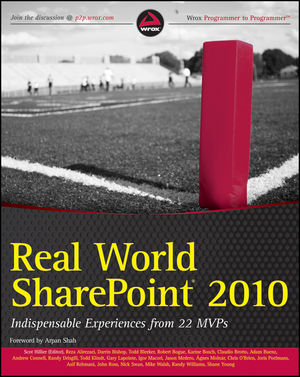Real World SharePoint 2010: Indispensable Experiences from 22 MVPsISBN: 978-0-470-59713-2
Paperback
816 pages
November 2010
 This title is out-of-print and not currently available for purchase from this site.
|
Foreword xxvii
Introduction xxix
Chapter 1: Building a Perfect Test Environment for SharePoint Server 2010 1
Getting Ready 2
Windows 2
SQL Server 12
SharePoint 2010 15
Other Software 33
Summary 33
About the Author 34
Chapter 2: Up grading to SharePoint Server 2010 — The Hybrid Approach 35
Understanding the New SharePoint 2010 Upgrade Process 36
System Requirements for a SharePoint 2010 Upgrade 36
SharePoint 2010 Upgrade Improvements 37
Dealing with Large Content Databases 46
Upgrading with Custom Site Definitions 47
Choosing the Right Upgrade Approach 50
SharePoint 2010 Hybrid Upgrade Approach 61
Summary 68
About the Author 68
Chapter 3: Monitoring SharePoint 2010 69
ULS 69
Trace Logs 70
Windows Event Logs 85
Logging Database 86
Health Analyzer 94
Timer Jobs 98
Summary 102
About the Author 102
Chapter 4: SharePoint 2010 Security Under the Hood — Claims‑Based Authentication 105
Introducing the Identity Metasystem 106
Identity in a Claims-Based World 107
The Security Token Service (STS) 108
The Problem with Multiple Identities 110
Claims Impact on Delegation 112
Mapping Technology to Components 113
Configuration of SharePoint Claims 114
Architecture of SharePoint Claims 120
Summary 126
About the Author 127
Chapter 5: Using PowerShell with SharePoint 2010 129
Understanding PowerShell Basics 130
Using SharePoint 2010 Cmdlets 144
Creating Custom Cmdlets 156
Summary 164
About the Author 164
Chapter 6: Backing Up and Restoring SharePoint 2010 165
Operations Planning 166
Types of Recovery 168
What’s New in 2010 170
Understanding the Types of Backups 175
Recovery Scenarios 194
Recommendations 201
Summary 204
About the Author 204
Chapter 7: Working with SharePoint Designer 2010 205
Evolution of SharePoint Designer 205
Who Should Use SharePoint Designer? 206
Requirements for Using SharePoint Designer 2010 207
What’s New? 208
Using SharePoint Designer Effectively in Your Environment 243
Summary 245
About the Author 246
Chapter 8: Building Sandboxed Solutions 247
The Push to No-Code Solutions 248
Understanding the Concept of a Sandboxed Solution 249
Your First Sandbox Project 255
Getting Out of the Sandbox 259
Exploring Alternatives to the Sandbox 265
Understanding When to Use Sandboxed Solutions 266
Summary 267
About the Author 267
Chapter 9: SharePoint 2010 Web Parts 269
Web Part History 270
Web Part Development 276
Web Part Basics 280
Creating a Simple Visual Web Part 295
Enhancing the Visual Web Part 320
Adding an Editor Part 323
Adding Web Part Verbs 330
Summary 332
About the Author 332
Chapter 10: Automating Business Processes 335
Using InfoPath and SharePoint Designer Individually 336
Combining InfoPath and SharePoint Designer 349
Summary 373
About the Author 373
Chapter 11: Building Custom Service Applications for the Right Situations 375
Understanding Services in SharePoint 376
History of Services in SharePoint 376
SharePoint 2010 Service Architecture Framework 377
SharePoint 2010 Service Application Extensibility 378
Creating the Wingtip Calculator Service Application 380
Summary 405
About the Author 405
Chapter 12: Managing the SharePoint Application Lifecycle 407
Provisioning with Solution/Feature XML Versus .NET Code 408
Generating Feature XML Using Site Templates 409
Upgrading a SharePoint Application 415
Assembly Versioning in a SharePoint Application 431
ALM and Sandboxed Solutions 437
Summary 438
About the Author 439
Chapter 13: Using Silverlight 4 with SharePoint 2010 441
The Silverlight News Banner 442
Developing a SharePoint Web Part Hosting a Silverlight Application 453
Deployment Possibilities and Accessibility Scope Impact 465
Developing a SharePoint Custom Field Type Hosting a Silverlight
Application 466
Developing a SharePoint Application Page That Hosts Several Communicating Silverlight Applications 485
Hosting a Silverlight Application in the Master Page 505
Using Business Connectivity Services 510
Using Silverlight from within a Sandboxed Solution 520
Summary 524
About the Author 524
Chapter 14: Business Connectivity Services 525
A Brief Look Back 526
Terminology Changes 526
Welcome to SharePoint 2010 527
Existing BDC Applications During an Upgrade 529
BCS Features Available in SharePoint Foundation 529
BCS Features Available in SharePoint Server 2010 531
Using Tools to Create ECTs 536
Developing Against the BCS Object Models 548
Summary 548
About the Author 549
Chapter 15: Using PerformancePoint Services 2010 551
The Case for Business Intelligence 552
PerformancePoint Services 2010 Overview 553
Configuring and Enabling PerformancePoint Services 555
Creating a PPS Dashboard 559
About the Author 576
Chapter 16: Managing Metadata with SharePoint Server 2010 577
Information Architecture 577
Taxonomy and Metadata 578
Taxonomy Versus Folksonomy 580
Metadata and Taxonomy Platform Enhancements 580
Programmatic Access to the EMM Service 600
Summary 604
About the Author 604
Chapter 17: Understanding SharePoint 2010 Search 605
New and Improved SharePoint 2010 Search 606
SharePoint 2010 Search Engines 608
Deploying SharePoint 2010 Search 613
Deploying FAST Search Server 617
Using PowerShell Commands 620
Building the Search Architecture 621
Customizing User Interfaces 630
Improving “Findability” and “Searchability” 633
Summary 636
About the Author 636
Chapter 18: Understanding Branding in SharePoint 2010 637
Introduction to SharePoint Branding 637
Exploring New Branding Features 647
Creating a Branded SharePoint 2010 Site 655
Summary 669
About the Author 669
Chapter 19: Planning, Designing, and Administering a Multimedia Assets Management Solution 671
Looking at Digital Assets Management Scenarios 671
Infrastructure Deployment 674
Designing the Data Foundation 682
Configuring and Developing the User Experience 685
Designing Custom Asset Library View Styles 693
Packaging the Solution in a Custom Site Definition 695
Notes from the Field 699
About the Authors 702
Chapter 20: Accessing SharePoint Data 703
Data Modeling 703
Data Access Options 704
Creating Sample Lists 706
Accessing SharePoint Data Using the Server-Side Object Model 707
Accessing SharePoint Data Using the Client-Side Object Model 730
Accessing SharePoint Data Using Web Services 738
Accessing SharePoint Data Using No-Code Solutions 743
Summary 744
About the Author 744
Chapter 21: Finding Answers to Your SharePoint 2010 Questions 745
Looking for Books 745
Continually Expanding Your Knowledge 747
Solving Sudden Problems 757
About the Author 762
Index 763



